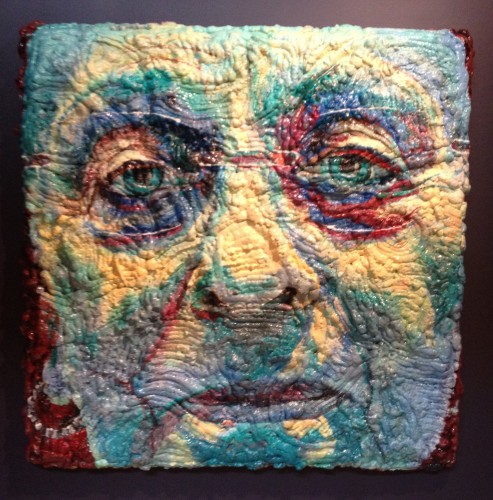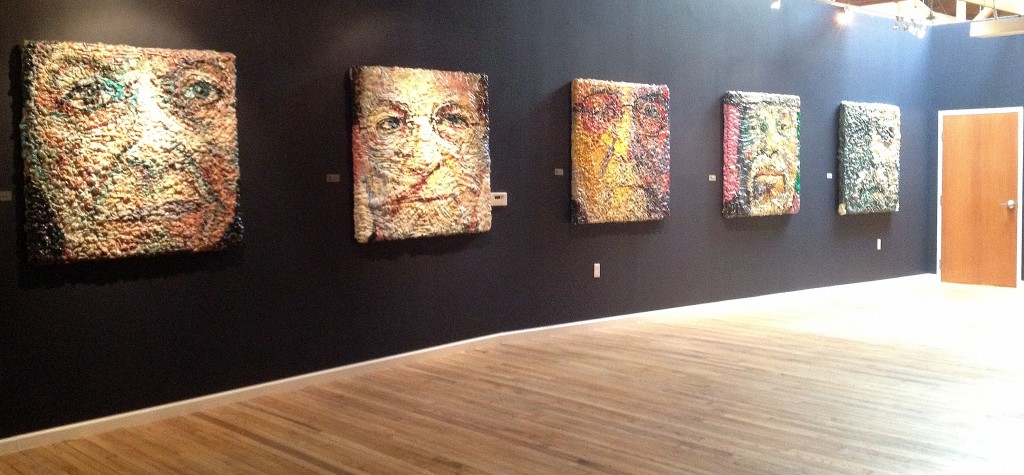Several years ago I did a portrait of a colleague. I did several preliminary sketches, I took numerous reference photos, and I poured my heart into every detail of the portrait. I had to start the portrait over on more than one occasion. In the end I created a portrait that captures her strength and energy. She hated it.
If you ever want to turn a friend to an enemy, paint a portrait of them. Portraits are a tricky art form. The artist wants to be true to his or her vision, but the sitter often wants a reflection of how they see themselves (which, at times, falls prey to the illusions of the mind where no matter what our age we always see our 18-year-old selves staring back at us in the mirror).
Jim Pallas knows the ups and downs of a portrait project. He undertook an ambitious project to paint the art giants of Detroit. He admits that some of the people he picked—artists, collectors, dealers, and critics who are “absolutely necessary for a healthy community” – are mad at him for how he portrayed them. He has some answers why: “Maybe because I showed them all lumpy. Maybe because I didn’t try to make them look younger or older. Maybe because I’ve never painted anything like this before and I’m not very good at it.” He then wonders, “Maybe my so-called career is over.”
Jim (who is a Detroit art giant in his own right) chose to create his homage to these pillars of Detroit arts through the use of bright colors, extreme close ups, and Styrofoam substrate. Yes, Syrofoam. Specifically, he created these portraits on four foot square surfaces of urethane foam on a Styrofoam substrate, the top surface of which is a layer of UV blocker. He then would use laminating epoxy with high quality artist’s pigment to paint the portraits. (He details his foam paintings on his website.) Needless to say, Jim challenged himself. This project also had the added challenge of everyone having an opinion about who was left off of the list of giants of the Detroit art scene – he stopped at sixteen arbitrarily.
But despite some negative reaction he received, Jim created one of the most moving exhibits I have seen this past year. These beautiful portraits art at the N’Namdi Center for Contemporary Art, 52 E. Forest, Detroit, Michigan, and runs through July 21, 2012.
The portraits are shown in the N’Namdi’s Black Box Gallery. As I walked in I was greeted with an intense reminder that Detroit’s thriving arts community has awe-inspiring, wise, trusted, and talented guides. As mentioned in my introductory post, I want to highlight the importance of individuals rather than buildings in creating a sustained and substantive art community. Jim and the people he chose to highlight are some of the most important individuals Detroit needs in order to have a sustained and substantive art community. With these art giants, Jim reminds Detroiters how lucky they are: there are some giants that cast shadows that trap the younger generation in darkness, because they are never given the tools to build on the past successes. Other giants lift the younger generation onto their shoulders so that they can see the sunlight. Detroit is blessed with art giants in the latter category.
You should Google each one of the individuals he chose to highlight. You will be amazed at their energy and impact. This is an energy and impact that Jim captured with his paintings.
Just in case you don’t Google all of these people right away, I just want to highlight some of them. First, Charles McGee is the grandfather of Detroit contemporary art. In 2008, The Kresge Foundation named Charles its first Kresge Eminent Artist. This $50,000 award was a much deserved recognition of his contribution to Detroit’s art scene. His work is in prestigious collections throughout the world, including a breathtaking permanent installation at the Detroit Institute of Arts. He is widely known to be devoted to mentoring younger artists. A younger art mentor is Tyree Guyton. Tyree’s crowning achievement is the Heidelberg Project. He transformed urban blight to a sprawling art installation that forces a smile onto the face of anyone viewing it. The Heidelberg Project recently celebrated its 25th anniversary, and is now a cultural village that hosts artist residencies, and it spotlights and mentors rising art stars.
Lila Silverman is a collector and Detroit philanthropist who has encouraged and supported contemporary and experimental art for decades. George N’Namdi similarly has supported contemporary art in Detroit and nationally for decades. He renewed his commitment to Detroit in 2010 by opening the N’Namdi Center for Contemporary Art – several galleries, a great restaurant, and a wine bar. (You cannot take a picture–or I guess paint one–of George without his trademark hat.) He is quick with a smile, advice, and an introduction to other people in the art community. Gilda Snowden similarly is quick to provide any help she can to younger artists. She is currently the Interim Chair and Professor of Fine Arts Department at the College of Creative Studies in Detroit. Her students praise her.
These are the people that give Detroit’s newest generation of artists the wisdom they need to succeed. These are the people in Detroit that deserve to be honored.
Jim Pallas does an exceptional job of honoring these giants. Sadly, the true impact of these paintings cannot be conveyed through a photograph of the work. True, you can see moving portraits that explore the sitter’s psyche through bold color and dark line. Yet these portraits are on an artificial surface of glossy mountains and valleys. You get lost in the form and contemplate the process of creating art. These portraits hit the viewer on several levels, so that you leave the Black Box with a greater appreciation for the art giants and for true creativity.
These are works that focus on thoughts and talent. These are not gimmicky works; rather, these are works where the artist challenged himself with material and texture and intimidating subjects. As Jim explains, “’Art Giants in Detroit’ is a homage to the dozen-plus sturdy creative souls … [who he has] observed for over 50 years [and] whose persistence and inner integrity have been a beacon to many countless younger artists.” He goes on to note that, “In the Detroit art community, they have grown to be regarded as giants.”
Hopefully the newest generation of artists will recognize and reach out to these giants. If they do, there is a greater chance that this latest burst of interest in the Detroit art scene will really change things and create sustained growth. The latest generation is lucky because new venues are popping up all the time, and the press has an ear towards Detroit’s art scene. (Jim noted that when he graduated in 1965, he looked up galleries in the Yellow Pages, and there were only eleven listings. Six of those listing were furniture stores).
Detroit artists now have a lot of venues to show their work. They also have a press that is interested. They also have the talent. Detroit artists just need to stand on some shoulders to see how great they can become.








Pingback: The Art Giants of Detroit | ArtSibs